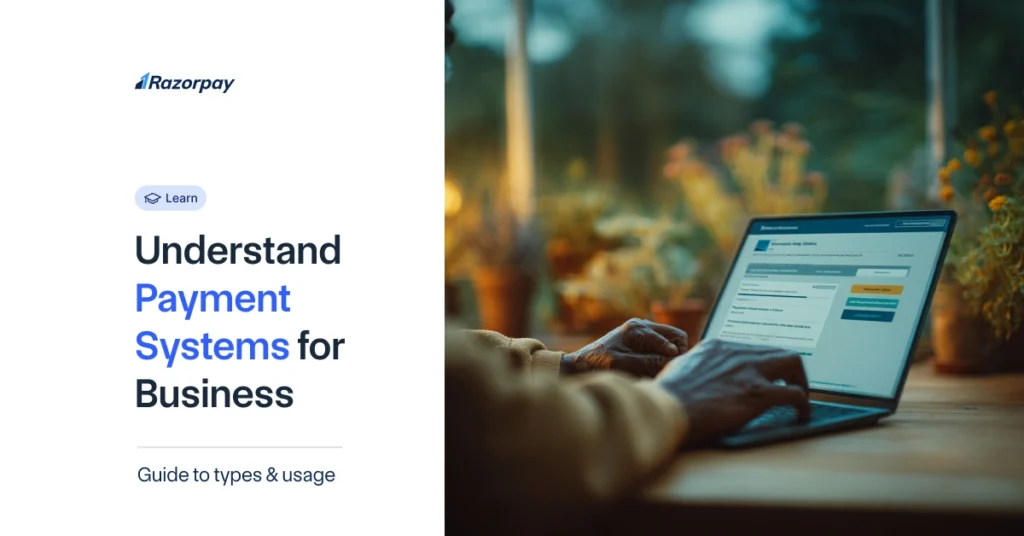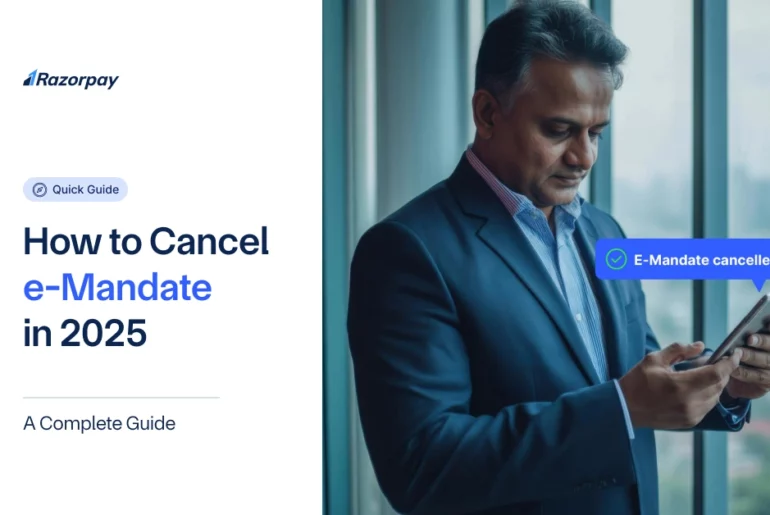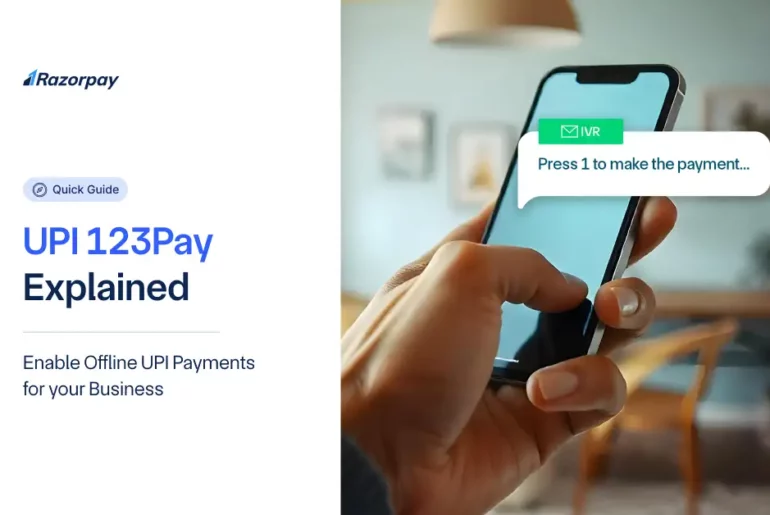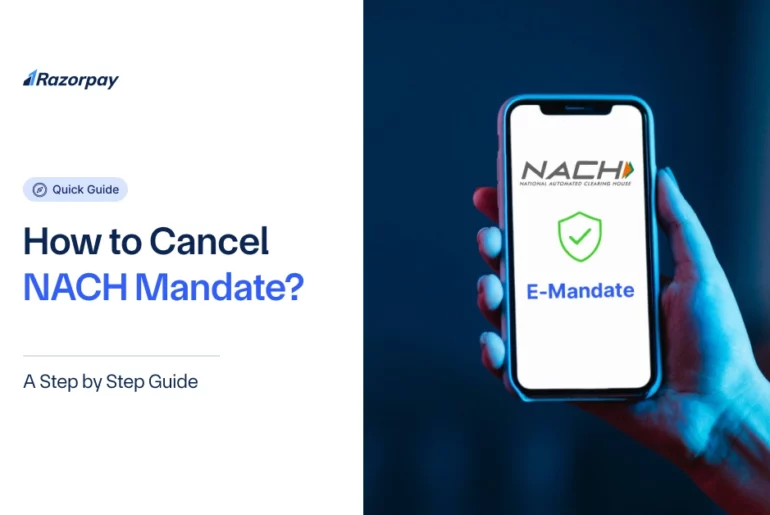You’ve built a great product and a beautiful website. However, when a customer clicks ‘Pay Now,’ what happens next? That entire process is your payment system, and it’s critical to your success.
Payment systems have evolved significantly over the years, transitioning from cash-based transactions to digital and mobile payments.
In India, the shift towards cashless transactions has been particularly pronounced, driven by the following factors:
- Widespread usage of smartphones and its adoption
- Government initiatives like Digital India, and
- Growing consumer trust in online payments
As we move towards 2025, Indian businesses must utilize the various payment systems available and how they can leverage them to optimise their operations, improve cash flow, and enhance the customer experience.
Table of Contents
Key Takeaways
- A payment system enables the secure transfer of funds between customers and businesses, functioning like the plumbing of commerce.
- India uses both cash-based and non-cash systems, with digital options like UPI, cards, and wallets growing rapidly due to convenience and better tracking.
- Digital payments involve multiple steps and parties—payment gateways, processors, banks—working together to authorize, process, and settle transactions securely.
- Efficient settlement and reconciliation are vital for maintaining healthy cash flow and accurate financial records.
What is a Payment System?
A payment system is a technology-driven infrastructure that enables the transfer of money between a buyer and a seller.
Think of it as the central nervous system of your revenue operations—it connects customers, banks, and intermediaries to ensure every transaction is processed securely, quickly, and accurately. Whether you’re accepting card payments, UPI, or digital wallets, the payment system ensures funds move from the customer’s account to yours with minimal friction.
Types of Payment Systems Relevant to Businesses
Cash-based Payments
Despite the rapid growth of digital transactions, cash remains a prevalent payment method in India, particularly in rural and semi-urban areas. Cash-based payments involve the physical exchange of currency notes or coins between the customer and the merchant.
While cash transactions are straightforward and do not require any additional infrastructure, they come with certain drawbacks for businesses:
- Cash handling costs, including the need for secure storage and transportation
- Risk of counterfeit currency
- Difficulty in tracking sales and maintaining accurate records
- Inconvenience for customers who prefer digital payment options
Non-cash Payment Systems
- Cheques
Cheques are still used by many Indian businesses, especially for high-value B2B transactions.
Benefits: -
- Suitable for large transactions
- Can be post-dated for scheduled payments
- Challenges:
- Clearance delays (typically 2–3 working days)
- Manual handling increases chances of human error
- Credit and Debit Cards
Card payments are widely accepted in retail, hospitality, and online businesses because they enable faster checkout and help improve customer experience.
Benefits:- Instant payment confirmation
- Accepted across multiple platforms
- Challenges:
- MDR (Merchant Discount Rate) charges cut into your profit
- Chargebacks can be complex to resolve
- Electronic Funds Transfer (EFT)
EFT includes NEFT, RTGS, and IMPS, commonly used for vendor payments, salary disbursements, and fund transfers.
Benefits:- Direct account-to-account transfers
- NEFT and RTGS are ideal for scheduled or bulk payments
Challenges:- NEFT and RTGS are limited to banking hours (for offline users)
- Incorrect details may lead to transaction failures
- Mobile Payments and UPI
UPI and mobile wallets have transformed the Indian payments space. As a business, you can accept payments instantly using a QR code or phone number.
Benefits:- No setup cost for UPI
- Widely adopted by Indian consumers
- Challenges:
- Daily transaction limits may not suit high-volume businesses
- Risk of failed transactions due to server or connectivity issues
- Digital Wallets
Digital wallets like Paytm, PhonePe, and Amazon Pay offer convenience to both customers and businesses, especially in low-ticket transactions.
Benefits:- Quick, contactless payments
- Useful for cashback and reward-based marketing
- Challenges:
- Withdrawal to bank account may attract charges
- Dependency on the service provider’s uptime
- Cryptocurrencies
Though not widely accepted in India due to regulatory uncertainty, cryptocurrencies are being explored by some tech-forward businesses.
Benefits:- Lower transaction costs in international payments
- Decentralised, which reduces third-party dependency
- Challenges:
- Lack of legal clarity in India
- Limited customer adoption
How a Payment System Works: From Customer Click to Bank Credit?
The entire payment lifecycle happens in three main stages: Authorisation, Clearing, and Settlement.
-
Authorisation
The customer initiates a payment. Your payment gateway sends the request to the acquiring bank, which forwards it to the customer’s issuing bank. The bank checks for sufficient funds and confirms or declines the transaction instantly.
-
Clearing
After authorisation, transaction details are passed through the card network to the issuing bank. This prepares both banks to move the money.
-
Settlement
Funds are transferred to your business account. This happens on a settlement cycle—usually T+1 or T+2, where “T” is the transaction date. Delays in this stage can affect your cash flow.
Key Components of Business Payment Systems
Payment Instruments
Payment instruments are the means by which customers initiate a transaction. In India, popular payment instruments include:
- Debit and credit cards
- UPI IDs and QR codes
- Digital wallet accounts
- Net banking interfaces
Merchants must ensure that their payment system supports a wide range of payment instruments to cater to diverse customer preferences.
Payment Gateways and Processors
Payment gateways and processors are essential components of a business’s payment system, facilitating the secure transmission and processing of payment data.
- Payment gateways encrypt and transmit payment information between the merchant, customer, and payment processor.
- Payment processors, such as acquiring banks or third-party providers, handle the routing and settlement of transactions.
Choosing reliable and efficient payment gateways and processors is crucial for ensuring a smooth and secure checkout experience for customers.
Role of Banks and NBFCs
Banks and Non-Banking Financial Companies (NBFCs) play a vital role in the payment ecosystem, acting as the issuing and acquiring entities for various payment instruments.
- Issuing banks provide customers with debit, credit, and prepaid cards, as well as net banking services.
- Acquiring banks and NBFCs enable merchants to accept card payments by providing them with necessary infrastructure and services, such as POS terminals and payment gateways.
Merchants must partner with acquiring banks or NBFCs that offer competitive rates, reliable services, and robust support to ensure the smooth functioning of their payment systems.
Settlement and Reconciliation
Settlement and reconciliation are critical processes in a payment system, ensuring that merchants receive the funds they are owed in a timely manner.
- Settlement involves the transfer of funds from the customer’s account to the merchant’s account, typically handled by the payment processor.
- Reconciliation is the process of matching and verifying transaction records between the merchant’s system and the payment processor’s reports.
Efficient settlement and reconciliation processes are essential for maintaining a healthy cash flow and accurate financial records for businesses.
Types of Payment Systems: What They Mean for Your Business
Card-Based Systems
- Transaction Costs: 1.5-3% of the transaction value
- Settlement Speed: 1-3 business days
- Ideal Business Use Case: Medium to high-value transactions, recurring payments, and international customers
Real-Time Retail Systems (UPI)
- Transaction Costs: 0-1% of the transaction value
- Settlement Speed: Instant
- Ideal Business Use Case: Low to medium-value transactions, peer-to-peer payments, and mobile-first customers
Bank Transfer Systems
- Transaction Costs: 0-1% of the transaction value
- Settlement Speed: Same day or next business day
- Ideal Business Use Case: High-value transactions, B2B payments, and customers without cards or digital wallets
The Indian Payment Ecosystem: What Your Customers Expect in 2025
UPI: The Undisputed Champion
UPI has revolutionised the Indian payment landscape, offering customers a simple, fast, and secure way to transfer funds directly between bank accounts. As of 2025, UPI is expected to maintain its dominance, with new features like UPI Lite for offline payments and UPI 123Pay for non-smartphone users further expanding its reach.
Card Networks (RuPay, Visa, Mastercard)
Card networks, both domestic and international, continue to play a significant role in the Indian payment ecosystem. RuPay, the indigenous card network launched by NPCI, has gained significant traction, offering lower transaction fees and promoting financial inclusion. Visa and Mastercard remain popular among urban consumers, with co-branded and EMI-enabled cards driving adoption.
NetBanking & e-Mandates
NetBanking and e-Mandates offer customers a convenient way to make payments directly from their bank accounts without the need for cards or digital wallets. These methods are particularly popular for recurring payments, such as utility bills and subscription services.
Empowering Businesses with Razorpay’s Payment Solutions
Razorpay is a leading payment gateway and payment system provider in India, offering businesses a comprehensive suite of solutions to accept and manage digital payments. With Razorpay’s payment gateway, businesses can easily integrate multiple payment methods, including UPI, cards, netbanking, and wallets, through a single API.
Razorpay’s payment system also includes advanced features like smart routing, auto-reconciliation, and real-time analytics, helping businesses optimise their payment processes and improve customer experience. Additionally, Razorpay offers value-added services such as Razorpay Capital for instant business loans and Razorpay X for current accounts and payouts, making it a one-stop solution for all business payment needs.
FAQs
What is the best online payment system?
The best online payment system for a business is a system that supports multiple payment methods, offers competitive pricing, and provides robust security features is generally considered ideal.
What is the difference between a payment system and a payment gateway?
A payment gateway is a technology that securely captures and transmits payment data between the merchant, customer, and payment processor. A payment system, on the other hand, is a broader term that encompasses the entire ecosystem of processes, technologies, and infrastructure involved in facilitating digital payments.
How can my business start accepting online payments?
To start accepting online payments, businesses need to partner with a payment gateway provider like Razorpay. This involves signing up for an account, completing the necessary KYC (Know Your Customer) processes, and integrating the payment gateway API into the business’s website or app.
How can I enable or disable specific payment methods for my business?
Most payment gateway providers offer a dashboard or API-based controls that allow businesses to enable or disable specific payment methods based on their preferences.
What documents are required to sign up with a payment provider like Razorpay?
The documents required to sign up with a payment provider may vary based on the business’s legal structure and industry. Typically, businesses need to provide the following:
- PAN card
- GST certificate (if applicable)
- Bank account details
- Ownership and business registration documents
What are the typical costs involved in payment processing?
Payment processing costs typically include the following components:
- Merchant Discount Rate (MDR): A percentage of the transaction value charged by the payment gateway or bank.
- Setup and maintenance fees: Some payment providers may charge a one-time setup fee or recurring maintenance fees for using their services.
- Chargeback fees: If a customer disputes a transaction and files a chargeback, the business may be liable for a chargeback fee.
What types of payment methods can my business accept?
With a comprehensive payment system like Razorpay, businesses can accept a wide range of payment methods, including:
- UPI
- Credit and debit cards (Visa, Mastercard, RuPay, American Express)
- Digital wallets (Paytm, PhonePe, Google Pay, Amazon Pay)
- NetBanking
- EMI payments
- Pay Later options



